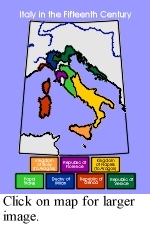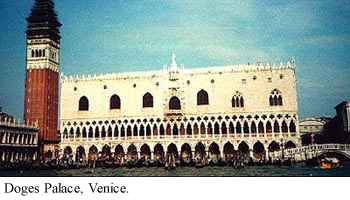The End of Europe's Middle Ages
The disorganization of the Holy Roman Empire, its ongoing dispute with the papacy over the extent of Church authority in secular government and absentee foreign overlords left Italians largely self-governing within their communes. At the start of the fourteenth century, Italy was a patchwork of independent towns and small principalities whose borders were drawn and redrawn by battles, diplomatic negotiations and marriage alliances. During the fourteenth and fifteenth centuries, many of these petty principalities consolidated into five major political units that precariously balanced power on the Italian peninsula: the kingdoms of Naples and Sicily, the Papal States and the three major city-states of Florence, Venice and Milan. The other minor city-states which co-existed with these larger powers made political stability in Italy even more tenuous as their loyalties shifted from one main force to another.
 |
Investiture Contests |
Only in the predominantly rural south did large territorial units continue to exist as fiefs of the Holy Roman Emperor and even they were constantly being stressed by feudal warfare. In the mid-thirteenth century, those states were administered by Manfred, the illegitimate son of Frederick II (1215-1250). Determined to reduce the threat of an imperial base so near to Rome, the papacy sought to eliminate German control from the Italian peninsula and offered the kingdom of Sicily to Charles of Anjou, a younger brother of Louis IX of France (1226-1270), in exchange for papal endorsement. Manfred was killed when the German forces were routed in 1266 and Charles of Anjou established the French Angevin dynasty in southern Italy and Sicily.
The papal plan had succeeded in eliminating the Germans from southern Italy. However, the inhabitants of Sicily resented French occupation and, following a bloody anti-French riot in 1282, offered their crown to Peter III of Aragon, Manfred's son-in-law. The violence of the riot developed into the War of the Sicilian Vespers which lasted for twenty years, leaving Sicily under Aragonese control while the rest of southern Italy was ruled by the Angevins from Naples. For the next nine decades, Angevin and Aragonese lords impoverished the region as each struggled to control his own territories and to gain ascendancy over his rivals.
The two kingdoms were finally reunited in 1435 when Alfonso the Magnanimous, king of Sicily, succeeded to the throne of Naples and became the king of Two Sicilies. The Aragonese line of Alfonso was able to maintain control of the kingdom and fend off Angevin claims until the end of the sixteenth century, when French forces invaded Naples, again turning Italy into a battleground for French-Spanish rivalries for generations.
The alliance of the papacy with the French crown had repercussions that were felt beyond southern Italy and Sicily. The Angevins saw themselves as champions of the Church and the popes became more and more dependent on the French monarchy for support. Increasingly, Italians felt distanced from a Church so heavily controlled by French interests and took exception to foreign influence. The situation worsened during the residence of the papal court in Avignon during the Avignonese Captivity (1308-1378) and the attitude of resentment was especially evident in the Papal States of central Italy.
The Papal States stretched across the middle of the Italian peninsula and provided agricultural and taxation support for the papacy. The region was exceptionally diverse culturally and a belligerent nobility made the area difficult to control even with a strong administrative presence at Rome. The absence of the papacy during the Avignonese Captivity combined with the decimation of the Plague, leaving the capital ravaged. Lawless brigands terrorized citizens and travellers alike throughout the area and wolves even roamed the streets of the city. Without a strong unifed government in Rome, central Italy was left to the mercy of princelings who used swords to carve out their own territories.
The continuous political strife and warfare drained the economy and exhausted the population of Italy. Civil unrest frequently burst into open violence and rioting as cities rebelled against feudal landholders over rights of self-government and taxation. The conflict between the papal Guelphs and the imperial Ghibellines was to the benefit of many cities and by playing these two factions against one another, civic governments were able to organize and squirm out from under the direct control of either. The ideologies of the parties were often retained but tailored to suit the ideals of the new communes and, although regularly labelled as either Guelph or Ghibelline, many towns shifted their allegiances with the political winds.
While many of Italy's towns and cities had originated from communes with republican ideals, most had become oligarchic in fact. During the late Middle Ages, two factors affected Italian civic politics. The first was the increased influence of the lower economic classes. The second was the rise of the despots.
The ultimate success of a city-state as an autonomous power was dependent on whether it could acquire the economic wherewithal to exist. It had to gain control over a sufficiently large portion of the surrounding contado to both provide a defensive zone and to generate adequate food and taxes. This process of urban expansion began in the twelfth century and by the thirteenth and fourteenth centuries, several city-states had acquired sufficient dominance to be considered major political powers and their influence was felt not only within Italy but throughout Europe.
The expansion of towns into the contado brought the grandi and contadini into the cities and with them often came long-standing feuds. Once in the cities, the grandi tended to reorganize their allies and perpetuated the vendettas they had carried from the contado. While the magnates of the city absorbed themselves in their feuds, the non-noble working classes assumed political power and enacted legislation to control the vendetta violence.
 |
Vendettas |
The rise of the popolo was critical and brought about some extremely sophisticated systems of government. The popolo remained, however, a class-based organization of guild members, professionals, craftsmen and labourers. It was as prone to factionalization as was the old aristocracy, splitting into the popolo grasso and the popolo minuto. The feuds of the aristocracy were soon replaced by political and economic rivalries within and between the classes of the popolo.
Florence is a typical example of a communal government based on the domination of the popolo grasso. The Ordinance of Justice in 1293 restricted participation in local politics to guild members and exiled familes known to either be hostile to the popolo or to be Ghibelline sympathizers. Although the popolo minuto was barred from open participation in civic government, the influence exerted by this class should not be underestimated. A particularly notable example is seen in the second half of the fourteenth century when, frustrated and beleaguered by the hardships created by the War of the Eight Saints, the lower classes of labourers and craftsmen of Florence overthrew the existing government and briefly seized power during the Ciompi Rebellion in 1378. This new regime lasted for only three years but awareness of the possibility of popular uprisings would remain.
 |
Florence |
The Ciompi Rebellion also played a part in permitting the nouveau riche to acquire political prominence. Following the collapse of the Ciompi regime in 1381, a coalition of major Florentine families guided the republic and managed to maintain domestic peace. From 1434 onwards, the Medici became the dominant power without openly claiming power, thus avoiding the charge of despotism and maintaining Florence's republican image. After Cosimo de Medici's death in 1464, power passed through a brief succession of mediocre heirs until his grandson, Lorenzo, 'Il Magnifico' (1440-1492) assumed control in 1469. A brilliant political strategist, Lorenzo utilized a network of banking and patronage arrangements and negotiated with other major powers to maintain political stability throughout Italy. To paraphrase the Italian historian, Guicciardini, "if one must have a despot, Lorenzo was a good one to have." Nevertheless, Lorenzo managed to avoid being called a despot by most of his contemporaries.
 |
The Medici in Florence |
One of the most dazzling courts of the time was that of the Visconti and Sforza dukes of Milan, beginning with the despot,
Giangaleazzo Visconti (1351-1402), who had married a daughter of the French king and purchased the title of Duke of Milan in 1395. His unexpected death
in 1402 left Milan without a capable leader until 1450 when his grandson-in-law, Francesco Sforza (1401-1466), took control. Unfortunately, a pattern of lacklustre descendants allowed control of Milan to pass to the French in 1499.
 |
The Visconti and Sforza of Milan |
Venice was the least typical of the Italian city-states of the late Middle Ages and early Renaissance. During the 1300s, Venice built on the knowledge of shipping and trade routes acquired during the Crusades of the twelfth and thirteenth centuries to develop an extensive commercial network stretching across the Mediterranean and even into the Black Sea and northern Europe. At the end of the fourteenth century, Venice had fixed her gaze outwards to her shipping lanes and stood as a world power relatively isolated from Italian infighting. Although actually governed under an oligarchic constitution, Venice succeeded in resisting despotic infiltration and executive power rested with the
Signoria, the
Senate and the
Great Council. The Signoria was headed by the
Doge, who was elected for life and whose office possessed the highest degree of splendour, respect and honour. An attempt to establish a despot in 1310 led to the creation of a committee of public safety, the
Council of Ten that exercised extensive power in protecting Venice against suspected enemies - foreign or domestic, political or economic.
With its dependence on its vast international commercial links, Venice was often involved in petty wars with rival Italian ports but in 1376 a full-fledged war began with Genoa and lasted until the Genoese forces were annihilated in 1380. After settling the Genoese problem, Venice met the threat of Milanese expansion by enveloping mainland areas that protected its northern trade routes and its food supply. This terra firma policy, however, forced Venetian attentions inland and away from its overseas ties until, by the middle of the sixteenth century, Venice had ceased to be the world power it once was. Still, Venice was the only major Italian state able to retain its republican status.
While the history of each Italian city-state is, of course, unique, the history of Italian politics is most significantly the history of the despots. In Italy, they achieved amazing levels of preeminence and the tools of diplomacy and espionage that they developed to retain their power set the standard for international relations throughout the Renaissance and into our own Modern era. Although Italy opened the door to the enlightenments of the Renaissance and the eyes of Europe turned to her for artistic guidance, her rulers continued to be split by their own squabbles. This lack of unity left Italy incapable of mounting successful defenses against the foreign invasions and occupations that were to come in the sixteenth century.
 |
Return to the Holy Roman Empire | Proceed to Eastern Europe |  |
The End of Europe's Middle Ages / Applied History Research Group / University of Calgary
Copyright © 1997, The Applied History Research Group

